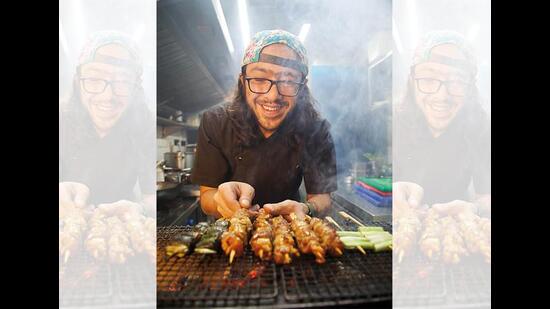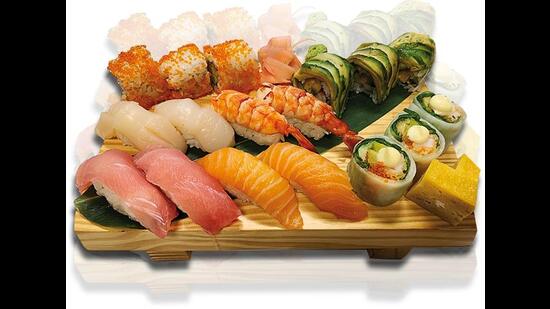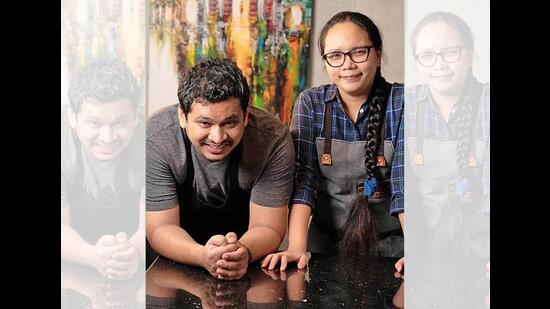Are you eating Japanese food these days? There are broadly three kinds of Japanese cuisine available in India. The first is traditional Japanese, which requires very specific (and often, hard-to-find) ingredients and chefs who have spent years training.
Then there is modern Japanese, popularised and mostly invented by Chef Nobu Matsuhisa in Los Angeles and New York. This was further refined by a German, the former Hyatt chef Rainer Becker, when he launched the first Zuma in London.
Between them, Nobu and Zuma have set the trend for modern Japanese, a more accessible version of the cuisine with pumped-up flavours. (Authentic Japanese has subtle and delicate flavours.)

And then there is what my friend Sameer Sain calls ‘disco Japanese’. In India, this takes the form of the kinds of sushi rolls that no Japanese person would eat, filled with masalas and spices. This is the kind of Japanese cuisine that has spread all over India because a) it can be spicy, b) Indians like the umami hit you get by dipping your rolls in soya sauce, c) you can put cooked and cheap ingredients into the rolls so you don’t have to worry about sourcing expensive raw fish and because no special training is required for chefs: any fool can make disco sushi.
Sushi first came to India at five-star hotels. After being rebuffed by Nobu, the Taj group turned to Masaharu Morimoto, who used to be Executive Chef at the New York Nobu. Morimoto’s cuisine has evolved in the years since he left Nobu but for Mumbai (and later Delhi), he served up the Nobu menu, convincing rich Indians that such dishes as Whitefish Carpaccio were authentically Japanese. Later, Augusto Cabrera started a sushi revolution in Delhi from a counter at 360º at the Oberoi.
In the 15 or so years that followed, modern Japanese has morphed into disco Japanese in India. You will get sushi rolls nearly everywhere now, even on menus where they share space with biryani. And the advantage that the five-star hotels had is gone: chefs trained by those hotels have set up elsewhere, they buy the same ingredients from the same suppliers and make food that is often better than the five-star version at one-third the prices.

I ate modern Japanese all over India in the last month and some of it was very good. The most expensive of the meals was at Megu at the Delhi Leela. Megu is one of only three restaurants in India to feature on the list of the 50 Best Restaurants in Asia. Conscious of the responsibility this places on the restaurant, Megu has tried hard to live up to its new prominence.
I went for lunch with my friends Gurjit and Neeru Singh. Gurjit served in Japan as an IFS officer and learned Japanese. Neeru, a distinguished international civil servant and diplomat, has also lived in Japan and speaks the language.

They were intrigued by many of the dishes that Chef Shubham Thakur served because modern Japanese cuisine is not very well known in Japan. But they conceded that the meal was delicious and had a Japanese vibe to it.
When the ITC Gardenia opened Edo in Bangalore, the idea was to appeal to Japanese expatriates in the city, so, the food was mostly traditional and authentic. Since then it has loosened up somewhat and the food is more modern Japanese. Edo is my default option when I eat in Bangalore and I reckon it is one of the country’s best Japanese restaurants, with the gifted Amit Patra as chef.

Even at expensive Japanese restaurants in India, the nigiri sushi is usually rubbish. The point of nigiri is not just the fish, it is the rice pellet. This must hold together but it cannot be very cold or too tight. The rice must be loose and stay together. Obviously, this is not easy to do and hardly anyone in India is trained to get it right.
I try not to order nigiri sushi in India because the rice is nearly always wrong so I notice when somebody does it well. I was surprised, for instance, to find good nigiri at the Pan Asian at the ITC Chola where a chef called Lok Thapa made much-better-than-usual rice pellets.
I was less surprised by the superior quality of the nigiri at Izumi, a standalone Japanese restaurant in Mumbai, because Nooresha Kably is one of India’s most gifted chefs and went to Japan to learn to get sushi right. Izumi does modern Japanese (and I guess some disco Japanese) but the quality of the ingredients and the attention to details is authentically Japanese. It is one of two outstanding Japanese restaurants in Mumbai.

The other is Mizu run by two young people, the entrepreneurial Vedant Malik and the talented chef Lakhan Jethani. They will do modern Japanese and even disco Japanese (Lakhan says that the demands of the market have forced him to add sushi to the menu) but the emphasis is on authentic Japanese flavours and techniques. On the night I went, it was the technical skills that impressed me the most: the dashi had depth, the chawanmushi was tremblingly perfect and even the made-up modern Japanese stuff was nicely executed: a nigiri topped with foie gras was perfectly torched.
Both Izumi and Mizu work on relatively low margins. They use the same expensive imported fish as the five-star hotels but charge half as much for their dishes as the hotels do. Plus, in both cases, (Nooresha and Lakhan) the chefs cook with real passion; they are not just marking time till they are transferred to a new hotel in a new city.

Such is the power of the modern Japanese boom that you get good quality modern Japanese nearly everywhere. Also in Mumbai is Seefah, named for the Thai chef who all of the city is crazy about. But Seefah, the restaurant, is much more than Seefah the chef. When Seefah cooked at the Mumbai Four Seasons, she met her husband Karan Bane, who worked with the hotel’s Japanese master chefs. So, more than half the menu of Seefah (the restaurant) is modern Japanese and, on the day I went, more people were ordering Japanese than were ordering Seefah’s delicious Thai food.
Delhi is less advanced than Mumbai when it comes to Japanese food (Bangalore may be ahead of both Mumbai and Delhi) but it is possible to get perfectly acceptable sushi rolls though they do lean towards disco Japanese. I usually order the rolls at Cha-Shi at Emporio or at the Café at Chanakya. Threesixty, the original sushi place, still serves rolls and I like the Japanese food at 361 at the Gurgaon Oberoi. In fact, the Oberois, more than any other chain, have learnt how to offer sushi rolls of a better-than-average standard at all their hotels: even Fenix in Mumbai does good sushi.

Does this mean a full-fledged sushi revolution has taken over urban India? Yes, it does. Does it mean that we love Japanese food? No, it doesn’t.
To understand the popularity of sushi rolls, you have to take them out of the context of the cuisine they originated in. People who love pizzas don’t necessarily love Italian food. People who love momos don’t always like Tibetan or even Nepali food. These are individual dishes that have flown out of their parent cuisines and become popular.
So, to Vada Pav, Chicken Lollipops and golgappas, add Disco Sushi!.
The views expressed by the columnist are personal
From HT Brunch, May 7, 2022



